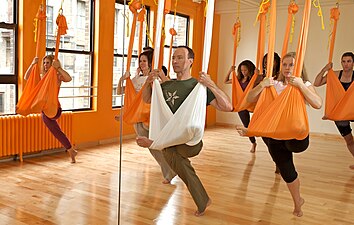Eka Pada Rajakapotasana

Eka Pada Rajakapotasana (Sanskrit: एक पाद राजकपोतासन; IAST: Eka Pāda Rājakapotāsana) or [One-legged] King Pigeon Pose[1] is a seated back-bending asana in modern yoga as exercise. The Yin Yoga form of the asana is named Swan Pose, while the Aerial yoga variant, supported in a hammock, is Flying Pigeon Pose.
Etymology and origins[]
The name comes from the Sanskrit words "eka" (एक) meaning "one"; "pada" (पाद) meaning "foot", "raja" (राज) meaning "king", kapota (कपोत) meaning "pigeon"[1] and asana (आसन) meaning "posture" or "seat".[2]
The pose is described in the 20th century by two of Krishnamacharya's pupils, Pattabhi Jois in his Ashtanga Vinyasa Yoga,[3] and B. K. S. Iyengar in his Light on Yoga.[4]
Description[]
Starting from sitting in Dandasana, one knee is bent, keeping the knee on the floor, so the foot is just in front of the groin, and the other leg is taken straight back. For the completed pose bend the knee of the rear leg, and grasp the foot or ankle with one or both hands.[4]
Variations[]
In Supported [King] Pigeon or Salamba Kapotasana, the rear leg is straight out and the hands are on the ground beside the hips, so the backbend is reduced. If comfortable, the back may be arched and the gaze directed straight upwards.[5][6]
In Sleeping Pigeon (or Sleeping Swan in Yin Yoga[7]), the rear leg is straight with the body and arms stretched forwards over the bent forward leg. This pose is sometimes named "Pigeon",[8] but it is a wholly different pose from the advanced kneeling backbend of Kapotasana.[4][9][10]
In Aerial yoga, Flying Pigeon Pose is a hammock-supported variant with one foot hooked across the front of the hammock.[11]
The pose can be practised with the rear knee against a wall, the lower leg vertical with a strap around the foot, working towards the full pose. The strap is grasped with both hands, the arms reversed so that the elbows point upwards.[12]

Aerial yoga class practising Flying Pigeon Pose, a hammock-supported variant[11]
See also[]
- Anjaneyasana, the closely related Crescent Moon pose, with the front foot on the floor and the front knee raised
References[]
- ^ a b "Eka Pada Raja Kapotasana - AshtangaYoga.info". Retrieved 2011-04-09.
- ^ Sinha, S. C. (1996). Dictionary of Philosophy. Anmol Publications. p. 18. ISBN 978-81-7041-293-9.
- ^ Sjoman, Norman E. (1999) [1996]. The Yoga Tradition of the Mysore Palace. Abhinav Publications. pp. 100–101. ISBN 81-7017-389-2.
- ^ a b c Iyengar, B. K. S. (1979) [1966]. Light on Yoga: Yoga Dipika. Thorsons. pp. 389–399. ISBN 978-1855381667.
- ^ Kirk, Martin; Boon, Brooke (2006). Hatha Yoga Illustrated. Human Kinetics. p. 118. ISBN 978-0-7360-6203-9.
- ^ "Salamba Kapotasana". Yogapedia. Retrieved 24 July 2019.
- ^ a b "Swan". Yin Yoga. Retrieved 24 July 2019.
Similar Yang Asanas: Proud Pigeon (Rajakapotasana).
- ^ Lidell, Lucy; The Sivananda Yoga Centre (1983). The Book of Yoga: the complete step-by-step guide. Ebury. pp. 132–133. ISBN 978-0-85223-297-2. OCLC 12457963.
- ^ a b Crandell, Jason (17 March 2016). "Master Sleeping Pigeon Pose in 4 Steps". Yoga Journal.
- ^ Rizopoulos, Natasha (16 July 2008). "The King of Hip Openers: Pigeon Pose". Yoga Journal.
- ^ a b Dortignac, Michelle (17 June 2015). "The Aerial Yoga Sequence: 9 Poses to Defy Gravity". Yoga Journal. Retrieved 4 June 2018.
- ^ Mehta, Silva; Mehta, Mira; Mehta, Shyam (1990). Yoga: The Iyengar Way. Dorling Kindersley. p. 143. ISBN 978-0-86318-420-8.
- Backbend asanas
- Hip-opening asanas
- Asymmetric asanas



